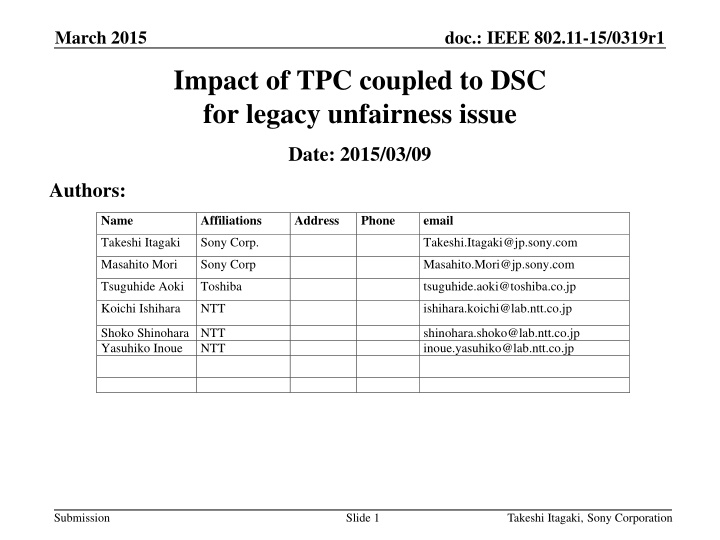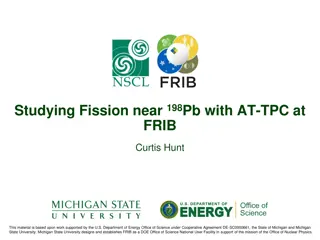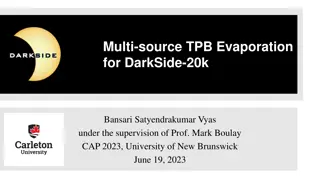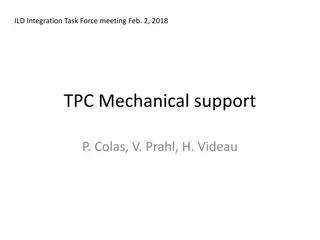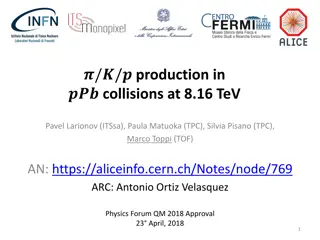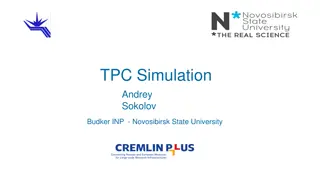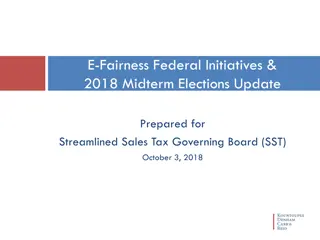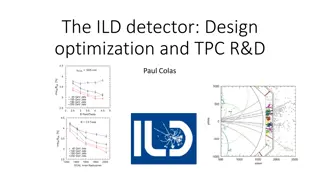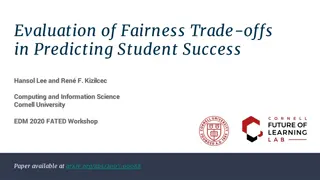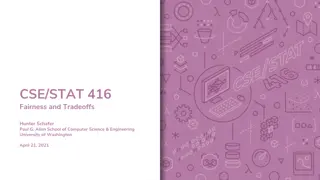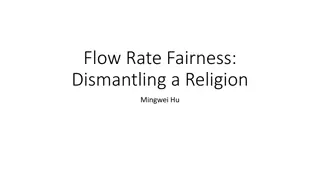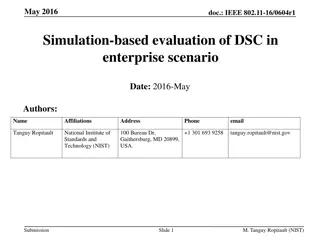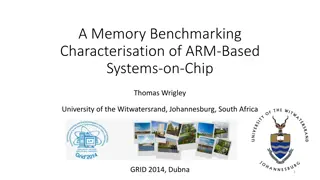Impact of TPC Coupled to DSC for Legacy Fairness Issue
Legacy fairness is crucial for 11ax networks. This submission explores the use of TPC coupled to DSC to address the legacy unfairness issue and maintain system gain while ensuring fairness in SS3. The study evaluates how increasing Tx occasions and desired Rx occasions can recover legacy fairness for Legacy STAs with the help of BSS Coloring and appropriate TPC and DSC parameters. The research delves into the implications of DSC algorithms and beacon RSSI-based algorithms for STAs, aiming to enhance performance and fairness in network operations near 11ax networks.
Download Presentation

Please find below an Image/Link to download the presentation.
The content on the website is provided AS IS for your information and personal use only. It may not be sold, licensed, or shared on other websites without obtaining consent from the author.If you encounter any issues during the download, it is possible that the publisher has removed the file from their server.
You are allowed to download the files provided on this website for personal or commercial use, subject to the condition that they are used lawfully. All files are the property of their respective owners.
The content on the website is provided AS IS for your information and personal use only. It may not be sold, licensed, or shared on other websites without obtaining consent from the author.
E N D
Presentation Transcript
March 2015 doc.: IEEE 802.11-15/0319r1 Impact of TPC coupled to DSC for legacy unfairness issue Date: 2015/03/09 Authors: Name Affiliations Address Phone email Takeshi Itagaki Sony Corp. Takeshi.Itagaki@jp.sony.com Masahito Mori Sony Corp Masahito.Mori@jp.sony.com Tsuguhide Aoki Toshiba tsuguhide.aoki@toshiba.co.jp Koichi Ishihara NTT ishihara.koichi@lab.ntt.co.jp Shoko Shinohara NTT Yasuhiko Inoue shinohara.shoko@lab.ntt.co.jp inoue.yasuhiko@lab.ntt.co.jp NTT Submission Slide 1 Takeshi Itagaki, Sony Corporation
March 2015 doc.: IEEE 802.11-15/0319r1 Abstract Legacy fairness is an important requirement for 11ax. [1] [TGax R9] Legacy performances shall not be significantly degraded by operation in or in proximity of 11ax network. The uplink performance of DSC combined with BSS Coloring has been shown in [2] BSS Coloring can increase the gain of DSC. But the unfairness issue wasn t resolved in the contribution In this submission, TPC coupled to DSC is considered and evaluated as a solution for recovering legacy fairness. It is shown that increasing system gain and maintaining the fairness can be satisfied simultaneously in SS3 by selecting appropriate TPC and DSC parameters. Submission Slide 2 Takeshi Itagaki, Sony Corporation
March 2015 doc.: IEEE 802.11-15/0319r1 Basic Setup AP AX STA Uplink Traffic (BSS Color filtering enabled) (DSC enabled, TPC on/off) In order to recover the fairness of Legacy STAs In order to In order to increase Tx occasion increase desired Rx occasion Submission Slide 3 Takeshi Itagaki, Sony Corporation
March 2015 doc.: IEEE 802.11-15/0319r1 Basic Setup AP AX STA Uplink Traffic (BSS Color filtering enabled) (DSC enabled, TPC on/off) In order to recover the fairness of Legacy STAs In order to In order to increase Tx occasion increase desired Rx occasion Why increasing desired Rx occasion is needed at AP ? -> To avoid wasting increased Tx occasion at STA w/o Color filtering at AP Interference Packet from OBSS Not detect due to DSC -> can transmit simultaneously time Tx to AP AX STA Cannot receive no matter how large the SINR is ! Detect -> start Rx time Rx Interference Packet AP * Although using DSC at AP side also increase Rx opportunity, it s difficult to select appropriate threshold dynamically. * So we use only COLOR in this submission. w/ Color filtering at AP Interference Packet from OBSS Not detect due to DSC -> can transmit simultaneously time Tx to AP AX STA Terminate Rx at PLCP -> can wait desired packet time Rx desired packet AP Submission Slide 4 Takeshi Itagaki, Sony Corporation
March 2015 doc.: IEEE 802.11-15/0319r1 DSC Algorithm STA: Beacon RSSI based algorithm with Margin parameter[3] CCA-SD = min(L, (RSSIBeacon M)) RSSIBeacon: RSSI of Beacon frame from associated AP [dBm] L: Upper Limit of CCA-SD [dB] M: Margin [dB] CCA-ED = -62dBm AP: Not applied CCA-SD = -82dBm CCA-ED = -62dBm [NOTE] The term CCA-ED represents 20 dB above the minimum modulation and coding rate sensitivity in this material. Submission Slide 5 Takeshi Itagaki, Sony Corporation
March 2015 doc.: IEEE 802.11-15/0319r1 TPC Algorithm STA: Basically reduce TxPower by amount of raising CCA-SD by DSC Also adjust by parameter . TxPower = min(PDefaultTx , (PDefaultTx D+ )) PDefaultTx: Default TxPower of STA = +15 [dBm] D: Amount of raising CCA-SD by DSC [dB] i.e. D = CCA-SDRaisedByDSC ( 82dBm) : Adjustment factor [dB] AP: Not applied TxPower = +23 dBm Submission Slide 6 Takeshi Itagaki, Sony Corporation
March 2015 doc.: IEEE 802.11-15/0319r1 Relation of DSC/TPC parameters Example of SS3 (2412MHz) STA AP +23dBm TxPower +15dBm Beacon (about -35dBm in this case) CCA-SD -82dBm Submission Slide 7 Takeshi Itagaki, Sony Corporation
March 2015 doc.: IEEE 802.11-15/0319r1 Relation of DSC/TPC parameters Example of SS3 (2412MHz) STA AP +23dBm TxPower +15dBm Beacon (about -35dBm in this case) DSC Margin CCA-SD D: Amount of raising CCA-SD -82dBm Submission Slide 8 Takeshi Itagaki, Sony Corporation
March 2015 doc.: IEEE 802.11-15/0319r1 Relation of DSC/TPC parameters Example of SS3 (2412MHz) STA AP +23dBm +15dBm Reduce by D. TxPower Beacon (about -35dBm in this case) DSC Margin CCA-SD D: Amount of raising CCA-SD -82dBm Submission Slide 9 Takeshi Itagaki, Sony Corporation
March 2015 doc.: IEEE 802.11-15/0319r1 Relation of DSC/TPC parameters Example of SS3 (2412MHz) DSC Margin and Adjustment value are varied at this time. STA AP +23dBm +15dBm Reduce by D. Beacon TxPower Further adjust by . (parameter) Data (about -35dBm in this case) DSC Margin CCA-SD D: Amount of raising CCA-SD -82dBm Submission Slide 10 Takeshi Itagaki, Sony Corporation
March 2015 doc.: IEEE 802.11-15/0319r1 Simulation Conditions Scenario-3 19-cell model with wrap-around (Reuse=3) Traffic model 10 uplink UDP Flows/BSS (Full-buffer condition) No downlink traffic MCS selection Goodput maximizing MCS based on SINR by training[4] CCA-SD control algorithm DSC : Beacon RSSI based algorithm[3] TxPower control algorithm DSC-linked control BSS Coloring mechanism[5] Enabled. (at AP and AX STAs) Parameters DSC-margin and TPC-alpha 30m 10m See backup slide for details Submission Slide 11 Takeshi Itagaki, Sony Corporation
March 2015 doc.: IEEE 802.11-15/0319r1 DSC performance (w/o TPC) BSS total throughput System throughput can be improved as DSC margin decreases. (No DSC/Color) DSC also causes legacy unfairness. Per STA throughput The performances with TPC for margin=35, 40 are shown in next slide. (No DSC/Color) Low CCA-SD High Submission Slide 12 Takeshi Itagaki, Sony Corporation
March 2015 doc.: IEEE 802.11-15/0319r1 DSC performance (w/ TPC) [NOTE] M in the graph represents the margin value of DSC. BSS total Remaining gain TPC coupled to DSC can recover fairness for Legacy STAs in return for decreasing certain system gain. throughput Original performance Increasing system gain and maintaining the fairness for Legacy STAs can be satisfied simultaneously by selecting appropriate M and . (e.g. M=40dB, =5~10dB) Recovering fairness Per Original performance Legacy STA throughput (ave.) * When DSC margin M < 35, system gain disappears when legacy fairness is recovered in this condition. High TxPower Low Submission Slide 13 Takeshi Itagaki, Sony Corporation
March 2015 doc.: IEEE 802.11-15/0319r1 Conclusion TPC coupled to DSC is considered and evaluated as a solution for recovering legacy fairness. Increasing system gain and maintaining the fairness can be satisfied simultaneously in SS3 by selecting appropriate TPC and DSC parameters. Next steps Further optimization of DSC/TPC control algorithm Evaluation of other penalty method coupled to DSC but TPC (e.g. EDCA parameter) Submission Slide 14 Takeshi Itagaki, Sony Corporation
March 2015 doc.: IEEE 802.11-15/0319r1 References 1. Lei Wang, Marvell, 11-14-1009-02-00ax-proposed-802- 11ax-functional-requirements 2. Masahito Mori, Sony, 11-14-1403-00-00ax- Performance Analysis of BSS Color and DSC 3. Graham Smith, DSP Group, 11-13-1290-01 Dynamic Sensitivity Control for HEW 4. Gwen Barriac, Qualcomm, 11-14-0851-02-00ax-rate- control-for-mac-and-integrated-system-simulations 5. Matthew Fischer, Broadcom, 11-13-1207-01-00ah- partial-aid-color-bits 6. William Carney, Sony, 11-14-0854-00-00ax-dsc-and- legacy-coexistence Submission Slide 15 Takeshi Itagaki, Sony Corporation
March 2015 doc.: IEEE 802.11-15/0319r1 Appendix Submission Slide 16 Takeshi Itagaki, Sony Corporation
March 2015 doc.: IEEE 802.11-15/0319r1 Simulation Setup details (AP x 1, STA x 10) x 19 (Half of STAs are AX STA, and others are Legacy STA) Node 5 Num of Drops [times] Uplink CBR UDP 30Mbps (from all STA -> Full Buffer condition), 20sec Traffic Model & Load & Duration AC_BE CWmin=15, CWmax=1023, AIFSN=3, TXOP limit=0 Access Category AP: +23, AX STA: Variable by TPC, Legacy STA: +15 Tx Power [dBm] Goodput maximizing MCS based on Training (MCS0 ~ 7) [4] MCS Selection (MPDU, MSDU, APP)=(1030, 1000, 972) Fixed Packet Length [byte] 10 L2 Retry Legacy 6.0Mbps Ack Rate OFF RTS/CTS (A-MPDU, A-MSDU)=(8KB, NA) Max Aggregation Size 7 NF [dB] TGn Channel D (pathloss, shadowing, fading) Channel (CenterFreq, BW)=(2412, 20) Channel Setting [MHz] AP: -82, AX STA: Variable by DSC[3], Legacy STA: -82 CCA-SD [dBm] -62 CCA-ED [dBm] [NOTE] The term CCA-ED represents 20 dB above the minimum modulation and coding rate sensitivity in this material. Enable (Error performance is shown in slide#18) Det. Cancel on PLCP err See slide #4 and #5 DSC / TPC algorithm AP and AX STA can handle COLOR information. (adding/filtering) STAs cannot filter packets that has no COLOR information (i.e. flow from Legacy STAs). BSS COLOR operation Submission Slide 17 Takeshi Itagaki, Sony Corporation
March 2015 doc.: IEEE 802.11-15/0319r1 Simulation Setup details Submission Slide 18 Takeshi Itagaki, Sony Corporation
March 2015 doc.: IEEE 802.11-15/0319r1 DSC performance (w/o TPC, 5%tile) All STAs (No DSC/Color) AX/Legacy STAs (No DSC/Color) Low CCA-SD High Submission Slide 19 Takeshi Itagaki, Sony Corporation
March 2015 doc.: IEEE 802.11-15/0319r1 DSC performance (w/ TPC, 5%tile) [NOTE] M in the graph represents the margin value of DSC. All STAs Original performance Legacy STAs Original performance High TxPower Low Submission Slide 20
